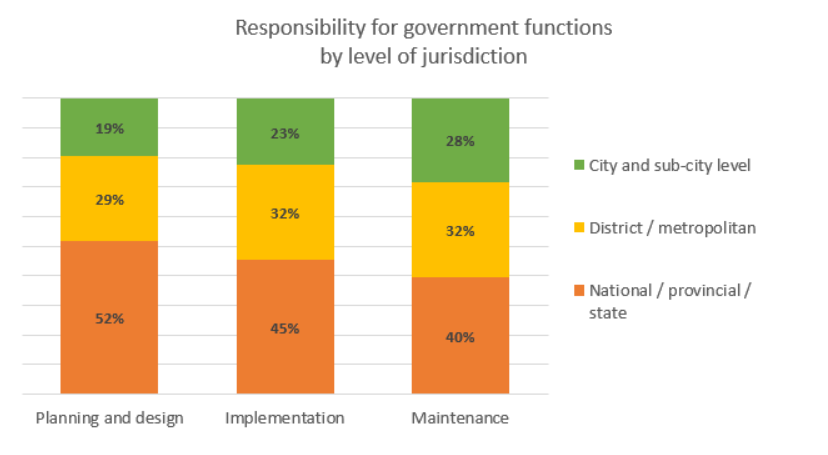Do cities control their own destiny?
One of the underlying assumptions of urban resilience oriented interventions is that cities control policies and vital systems, such as system-level management of infrastructure development, natural resource management, and setting environmental standards.
For example, the Global Facility for Disaster Reduction and Recovery (GFDRR) helps develop tools and knowledge that aid city level decision-makers and municipal leaders in determining how to reform policies, and where and how to invest to increase their city's resilience. 100 Resilient Cities departs from a common set of factors and systems that enhance a city's ability to survive, adapt, and grow in the face of adversity. The associated cities resilience framework describes the essential systems of a city and "drivers," which reflect the actions cities can take to improve their resilience. The GEF supported sustainable cities IAP program also departs from the idea that most cities have direct control over their transit system, roads, markets, waste management, water supply, wastewater treatment, building codes, and others. And city leaders play an essential role in the multiple levels of governance of urban management, necessitating their direct engagement.
To what extent do cities have direct local control?
A survey conducted as part of the formative evaluation of GEF's sustainable cities IAP program asked respondents to indicate at what level of government the responsibility for various government functions rests. Many of the respondents identified multiple levels of responsibility for city infrastructure planning and design, implementation and maintenance. The data revealed that, when moving from planning and design to implementation, and then to maintenance, the identified level of responsibility becomes slightly more localized.

The results of the survey do not support the direct local control and decision-making assumption, and there is a risk that the level of decentralized control a city has over its own resources and future might not be sufficient to make the changes needed to survive, adapt, and grow in the face of adversity.
Which area do cities control?
Most survey responses indicate that ‘land use', ‘solid waste' and ‘green spaces and parks' are identified as a city and municipal responsibility. Most responses identify ‘water delivery' as a provincial/state responsibility. Wastewater, ‘roads and waterways', ‘mass transit' and ‘industrial land development' are identified as multi-jurisdictional with a stronger locus of control with national governments.
The survey was a relatively small population of 65 targeted government officials, resulting in a sample of 26 completed surveys covering 23 cities in 10 countries. Sixty-one percent of respondents identified themselves as working at the national level. Also, city-level governance will look differently in a country that has a more centralized governance system, compared to more decentralized national level systems. Nevertheless, it does suggest that the assumption of local and direct control and agility may be over-simplified and does not accurately portray actual urban decision-making conditions.
Next steps
The future of the world's cities is not just in the hands of city-level planners and policy makers; cities are governed through a myriad of interconnected systems and institutions, resulting in a multi-level, multi-judicial governance system that differs city-by-city. The question remains whether that level of complexity is always adequately captured in today's urban resilience programming, and I would like to invite the reader to share his or her good examples on incorporating multi-level control and decision-making into urban programming.
Some Resources:
- IEO, Draft Final Report of the Sixth Comprehensive Evaluation of the GEF (OPS6), October 2017. Council Document GEF/ME/C.53/Inf.01.
- IEO, Formative review of the integrated approach pilot (IAP) programs, November 2017. Council Document GEF/ME/C.53/Inf.04.
- GEF, PDF document of Cities-IAP: Sustainable Cities Integrated Approach Pilot (IAP-PROGRAM), GEF ID 9077, April 2015.
- GEF, Sustainable Cities Program, 4-Page Glossy, November 2017.



